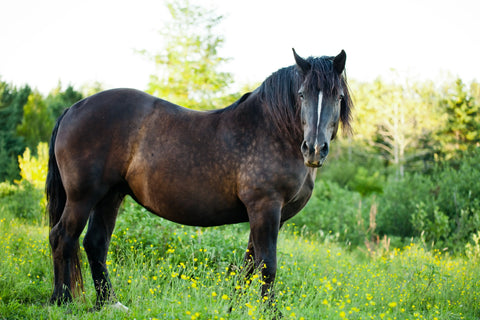
Deworming Horses: When, How and Why?
of reading - words
Why deworm your horse? 💉
The risks of internal parasites in horses
internal parasites are a permanent threat to the health of horses. They live in the digestive tract, lungs and other organs, feed on the nutrients of their host and weaken its organism.
Uncontrolled, a parasitic infestation can cause weight loss, digestive problems, colic and reduced performance. Some parasites migrate through tissues, causing irreversible internal damage.
Young horses, weakened individuals and older horses are more vulnerable, requiring strict deworming management.
What are the signs of a parasitized horse?
An infested horse does not always show obvious signs, but certain symptoms should alert you:
✔ Weight loss despite a correct diet
✔ Dull hair, brittle hair, loss of vitality
✔ Swollen stomach, abnormal bloating
✔ Diarrhea or irregular droppings
✔ Tail rubs (sign of pinworms)
✔ Recurrent colic
✔ Cough and difficulty breathing (certain lung parasites)
A coproscopy (analysis of droppings) makes it possible to assess the presence of parasite eggs and adapt deworming.
Consequences on health, digestion and performance
A parasitized horse assimilates the nutrients from its food less well. He draws on his reserves, which results in:
- Muscle loss and chronic fatigue
- Lower immune defenses → more frequent infections
- Intestinal irritations and ulcers caused by migrating larvae
- Respiratory problems for horses with lung parasites
Sport horses experience a decline in performance, and older or weakened horses can develop serious complications.

What are the most common parasites?
| Parasite | Description | Features |
|---|---|---|
| Small strongyles (cyathostomes) | Most common in horses. Their larvae encyst in the intestinal wall and can remain inactive for several months before emerging en masse, causing severe diarrhea and rapid weight loss. | ✔ Present in almost all horses ✔ Main risk: their encystment phase ✔ Increasing resistance to classic wormers |
| Large strongyles | Once very widespread, they have become rare thanks to regular deworming. Unlike small strongyles, they migrate through the horse's arteries, causing blood clots and fatal colic. | ✔ Uncommon but dangerous ✔ Internal damage often irreversible ✔ Mainly affects non-wormed horses |
| Ascaris | Very common in foals and young horses, because their immune system does not fight them effectively. They can measure up to 40 cm and cause intestinal obstruction. | ✔ Mainly affects young horses (under 2 years) ✔ Causes growth retardation ✔ Migration through the lungs → cough and nasal discharge Foals must be dewormed with a suitable product from their first month of life. |
| Tapeworms | Attaches to the junction between the small intestine and the cecum, causing intermittent colic. It is transmitted by mites present in grass. | ✔ Difficult to detect by coproscopy ✔ Responsible for severe digestive colic ✔ Present especially in horses living in pasture A specific dewormer (praziquantel) is necessary to eliminate the tapeworm. |
| Pinworms | Cause intense itching around the anus, leading horses to rub their tails on walls or water troughs. | ✔ Not very dangerous but very irritating ✔ Difficult to eradicate because they lay eggs around the anus ✔ Regular cleaning of the environment essential |
| Gasterophiles | Fly larvae that cling to the horse's hair before being ingested when it licks itself. They then settle in the stomach and cause ulcers and irritation. | ✔ Visible presence in the form of small yellow eggs on the limbs ✔ Not detectable by coproscopy ✔ Regular brushing to avoid their ingestion |
Which parasites specifically affect foals and young horses?
roundworms are the most worrying for foals. Their rapid growth leads to heavy accumulation in the intestine, which can cause fatal obstruction.
Young horses are also vulnerable to strongles and should be dewormed more often than adults, because their immunity to the parasites has not yet developed.

When and how to deworm a horse? 🏇
How often should you deworm?
The frequency of deworming depends on the age of the horse, its lifestyle and the level of parasitic infestation. A horse living in a meadow does not have the same risks as a horse in a box.
Program for a horse in the meadow
A horse in the meadow is more exposed to parasites because it lives in an environment where eggs and larvae are present in the grass. It is essential to adapt deworming according to seasonal parasites.
Typical program:
✔ Spring (April-May): Dewormer targeted against strongyles and roundworms (macrocyclic).
✔ Summer (July-August): Control of gastrophiles (specific dewormer after removal of eggs).
✔ Autumn (October-November): Tapeworms and strongyles (combination praziquantel + ivermectin/moxidectin).
✔ Winter (January-February, if necessary): Maintenance dewormer after coproscopy.
coproscopy can avoid unnecessary deworming and limit resistance.
Program for a boxed horse
A stabled horse is less exposed to parasites but is not free of risk. Strict hygiene reduces contamination, but certain parasites such as pinworms and strongyles persist.
Typical program:
✔ 2 to 3 dewormings per year, targeted according to dropping analysis.
✔ Treatment against tapeworms at least once a year.
✔ Vigilance for pinworms, especially if the horse scratches its tail.
Maintenance of the box (regular cleaning, clean litter) is essential to limit reinfestation.
Deworming of foals, young horses and older horses
Foals are very sensitive to parasites, particularly roundworm. Their deworming program must be rigorous.
✔ 1ᵉʳ month: First wormer against roundworms.
✔ Every 2 months up to 1 year: Alternation of molecules to avoid resistance.
✔ After 1 year: Transition to a progressive adult program.
older horses often have weakened immunity. Reinforced monitoring and regular coproscopies make it possible to adapt treatments.
What factors influence the need for deworming?
✔ Lifestyle: A horse in the meadow has more risks than a horse in a box.
✔ Hygiene: A poorly maintained pasture or stable encourages the proliferation of parasites.
✔ Number of horses in the same space: The more horses there are, the faster the contamination.
✔ Age and state of health: Young people and weakened horses are more susceptible.
✔ Climate and season: Some parasites are more active depending on the temperature and humidity.
An effective deworming program is not based solely on systematic treatments, but on reasoned management adapted to the horse's living conditions.

What are the different types of dewormers available?
Families of wormers and their spectrum of action
Dewormers are classified into several families depending on the parasites they target.
| Family | Targeted pests | Examples of molecules |
|---|---|---|
| Benzimidazoles | Strongles, roundworms, tapeworms (partial) | Fenbendazole, Oxibendazole |
| Macrocyclics | Strongles, gastrophiles, roundworms | Ivermectin, Moxidectin |
| Pyrantel | Tapeworms, strongyles | Pyrantel embonate |
| Praziquantel | Tapeworms only | Praziquantel |
Each dewormer has a specific spectrum of action and must be chosen according to the parasites present and the periods of risk.
Why alternate molecules to avoid parasitic resistance?
Repeated use of the same dewormer can lead to parasite resistance.
✔ Strongyles are most concerned by resistance.
✔ The alternation of molecules prevents parasites to adapt.
✔ Coproscopy allows treatment to be adjusted and avoid unnecessary deworming.
macrocyclics (ivermectin, moxidectin) are effective but should be used in moderation to avoid widespread resistance.
Chemical wormers vs. natural wormers: what alternatives?
Chemical dewormers remain the most effective method, but some natural alternatives are being explored.
✔ Diatomaceous earth: Mechanical action against certain intestinal parasites.
✔ Worming plants (garlic, tansy, thyme): Repellent effect, but not sufficient to eliminate an advanced infestation.
✔ Clay cure: Helps eliminate post-worming toxins.
How to avoid overuse of dewormers?
The importance of coproscopy for targeted treatment
The coproscopy is an essential tool for adapting deworming to the real needs of the horse. Rather than administering a systematic dewormer, analyzing droppings makes it possible to detect the presence and quantity of parasite eggs.
✔ Helps avoid unnecessary deworming
✔ Identifies the parasites present to choose the appropriate molecule
✔ Reduces the risk of parasitic resistance
A coproscopy must be performed in spring and fall to adjust the treatment. A horse with a low parasite load does not need to be dewormed immediately. This approach is more economical and more respectful of the horse's health.
What are the risks of parasitic resistance?
Excessive use of dewormers has led to increased parasite resistance, rendering some treatments ineffective.
✔ Strongyles are the most affected by this resistance
✔ The molecules most affected: Benzimidazoles and pyrantel
✔ Deworming without coproscopy worsens resistance
An overly wormed horse develops a weakened intestinal flora, which can impact its digestion and immunity. The alternation of molecules and the rotation of pastures are essential strategies to limit this phenomenon.
Reduce contamination and limit reinfestation
Cleaning of meadows and boxes
A clean environment significantly reduces parasite load.
✔ Remove droppings from meadows and boxes at least once a week
✔ Avoid overpopulation of paddocks: the more horses there are, the faster the contamination
✔ Leave a meadow to rest for several months to limit reinfestation
✔ Promote rotational grazing: alternate horses with cattle or sheep, which are not susceptible to the same parasites
A horse dewormed and returned to an infested pasture will quickly be reinfected. Environmental management is as important as deworming itself.
Should all the horses in a stable be dewormed at the same time?
In a stable, some horses may be more parasitized than others. Deworming the entire herd at the same time is not always necessary, but can be a good strategy in case of a heavy infestation.
✔ If several horses share the same meadow → it is preferable to deworm them simultaneously
✔ If the horses live in a box with little contact → individual deworming after coproscopy is sufficient
Deworming an entire group without coproscopy can be counterproductive and increase parasitic resistance.
Good practices to limit reinfestation
✔ Deworm at the right times (following parasite cycles)
✔ Clean water points and feeders regularly
✔ Do not allow droppings to accumulate in living areas
✔ Promote pasture rotation
Good environmental management drastically reduces the parasitic load, thus limiting the need for chemical dewormers.

Univers Cheval's opinion on reasoned deworming💡
Parasite management is not limited to administering a dewormer on a fixed date. A smarter approach, based on dung analysis, molecular rotation and environmental maintenance, makes it possible to reduce the need for chemical wormers while protecting horses' health.
Resistance to dewormers is a real problem and must be taken into account. coproscopy should be a systematic reflex before any treatment, to target only truly infested horses.
A healthy, well-fed horse living in a clean environment will have greater natural resistance to parasites, reducing the need for excessive deworming.









